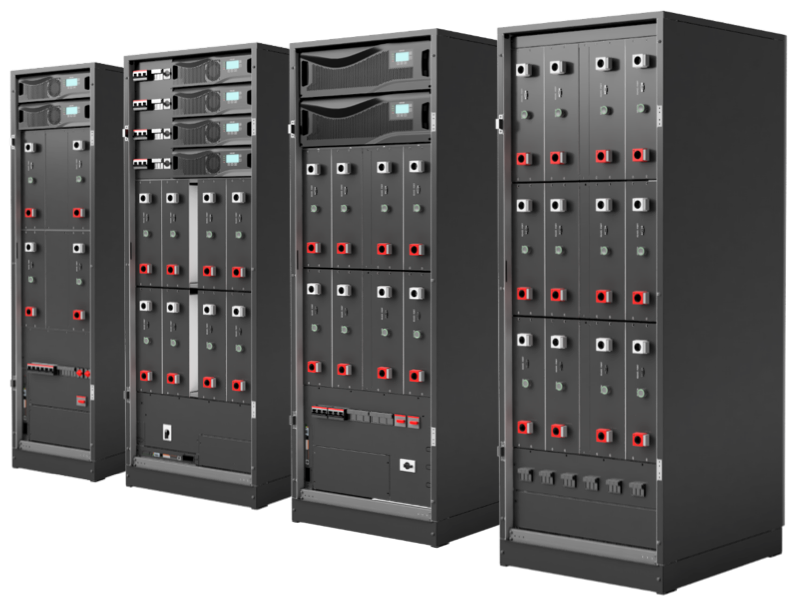Why Li-ion Will Be the Future of Data Centre Back-up Power
By Mike Elms, Managing Director, CENTIEL UK Ltd
Advances in Li-ion batteries in recent years now see the technology being used in many applications including our everyday electronic devices, in our cars, on planes, submarines and even on the International Space Station. However, the take up for Li-ion in the UPS industry has been much slower.
The Valve Regulated Lead Acid (VRLA) batteries we have used to back-up UPS systems for around 30 years, still do their job and they do it well: so why change? One area which may encourage the widespread adoption of Li-ion into data centers is the need for energy management. Unlike Lead Acid, Li-ion batteries are happy running at a temperature of high twenty/low thirty degrees centigrade. Similarly, most IT systems work at >250C and the UPS technology itself can work well up to 400C. By contrast: an industry standard estimate is that for every 10 degrees above 200C the operating life of a VRLA battery is halved. In many European locations this means cooling could, in future, be provided by the natural air temperature, if cooling is needed at all. This would result in significant savings on data center running costs and reducing carbon footprints.
Space saving is also a potential advantage. Many data centres have enough room to house Lead Acid batteries without issue. However, where space is at a premium, Li-ion batteries typically require less than half the physical space of the equivalent Lead Acid blocks and are less than 25% of the weight.
With the rapid increase in data being generated, soon to be fuelled further by the Internet of Things (IoT), only essential data will need to be moved to the cloud and stored at the big data centres. In the future, it is likely that many more, much smaller regionally based, edge data centres will process and accumulate the less essential information. These might be situated every half mile or so in a big city for example. Or, we may even have mini-data centres attached to our offices and homes. Here space will certainly be at a premium and Li-ion batteries will offer a practical alternative, providing significant space savings over VRLA cells.
One drawback of switching to Li-ion up until now has been the cost. However, prices are being increasingly driven down by the automotive industry and have reduced significantly over the past ten years. Increasingly, we are being asked to provide comparative quotes for Lead Acid versus Li-ion batteries for UPS installations. Depending on the project, we are generally finding the initial CAPEX cost of buying Li-ion compared with Lead Acid batteries works out at around twice as expensive.
However, Li-ion lasts twice as long and so considerations relating to total cost of ownership (TCO) have now started outweighing concerns about the initial investment. Ten-year design life Lead Acid batteries are normally replaced every seven or eight years. With Li-ion this is 13-15 years.
In the past, there have been safety concerns relating to Li-ion batteries and there have been some publicised stories about the fire risk of Li-ion technology over the years. However, any technology which is not managed correctly is potentially hazardous. If the proper procedures are not followed it is dangerous to drive a vehicle, fly a plane or even just cross the road!
The management and testing of Li-ion batteries is covered by the IEC62619 standard which was introduced internationally last year and relates specifically to the control systems in industrial batteries. Li-ion batteries are more sensitive to how they are charged and discharged and therefore are all required by IEC62619 to have an internal battery management system (BMS). This prevents the organic liquid electrolyte becoming too hot through over or undercharging. The BMS provides a warning if the safe envelope voltage range is exceeded and then the compatible UPS can respond. If this is ignored, a level two alarm is linked to a circuit breaker to prevent further charging or discharging of the cell. This double protection level needs to be implemented and tested to comply with IEC62619 regulation.
Every battery, including Lead-acid batteries, are a potential hazard but managed correctly, Li-ion technology has now been developed to be safe to use in data centres and other facilities requiring critical power protection.
There are different types of Li-ion batteries available. The type most suited to the application depends on the project and this is usually related to the required voltage. For a 12V Li-ion battery to replace a 12V Lead Acid cell, Li-phosphate would be suitable as the voltage is compatible. Note, for safety and as required by the IEC62619 standard: a 12V Li-ion battery will still require a BMS just like any other Li-ion battery.
A high voltage UPS of say 500V needs to keep batteries in balance. The voltage in every cell needs to be measured to indicate the state of charge. Here mixed metal oxide Li-ion batteries are most appropriate as, unlike Li-phosphate, the remaining autonomy can most easily be assessed and monitored across the range of cells.
The future will undoubtedly see the take up of Li-ion in the UPS industry. However, the roll-out across the data centre industry will not happen overnight. Not all systems are Li-ion ready, manufacturers of UPS equipment need to ensure their technology is compatible and can ‘talk’ to the Li-ion battery monitoring system.
Interestingly, the adoption of Li-ion within UPS systems so far, has been greater in developing countries in Africa and the Middle East, where the main power grid is less reliable than in the UK and frequent power problems are more commonplace. In these instances, the UPS and battery systems are required to be cycled several times per day. This greater take-up is primarily due to the higher cycling life of Li-ion: typically, 2,500 power-up and down cycles compared with around 300 for VRLA technology.
This may point to another potential application of Li-ion in the future. With increasing pressure being put on our cities’ energy supplies, demand side management of power could see data centres being paid for their excess energy. Rather like consumer solar panels, stored energy could be fed back into the grid during downtime and the UPS could move from becoming a data-backup hub to a bank account, generating income through taking advantage of power demand and use. Li-ion’s ability to be powered up and down could potentially offer interesting applications in this area for the future.
CENTIEL’s Li-ion solution is already being installed by our most forward-thinking UPS clients, who are looking to capitalise on the advantages that Li-ion has over lead-acid batteries, namely: they are smaller, lighter, have a high-power density, a longer life and operate at higher temperatures. Over the next five years we anticipate that a significant industry changeover to Li-ion will occur. The good news is that CENTIEL’s technology is already Li-ion Ready, so existing lead acid battery installations will have the option to upgrade to Li-ion in the future without needing to replace the UPS.
Originally featured in Data Centre Network News February 2019

